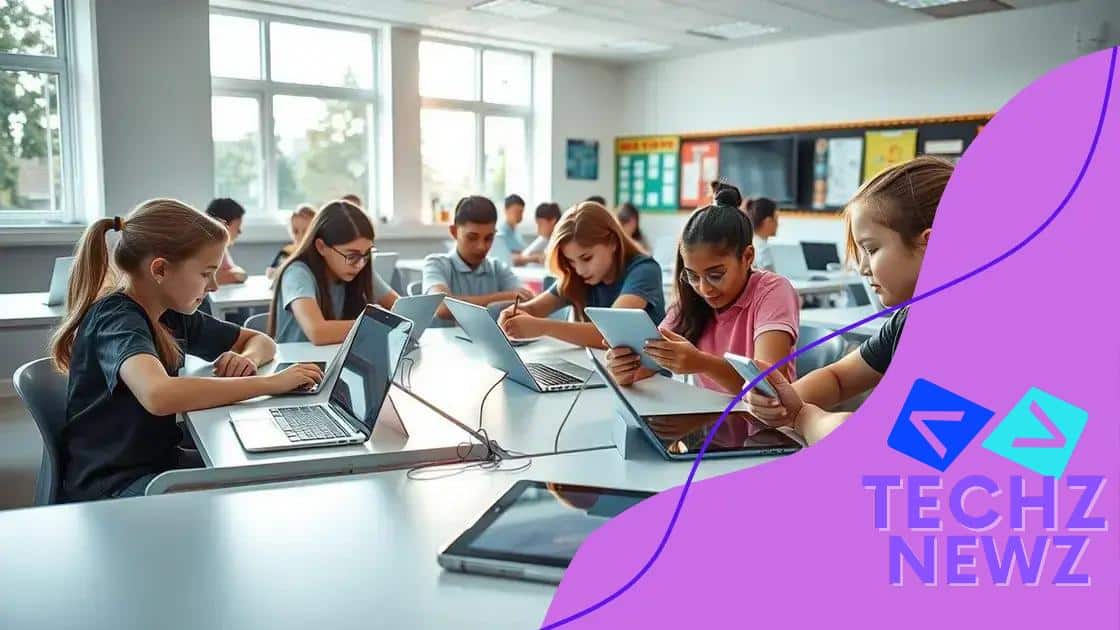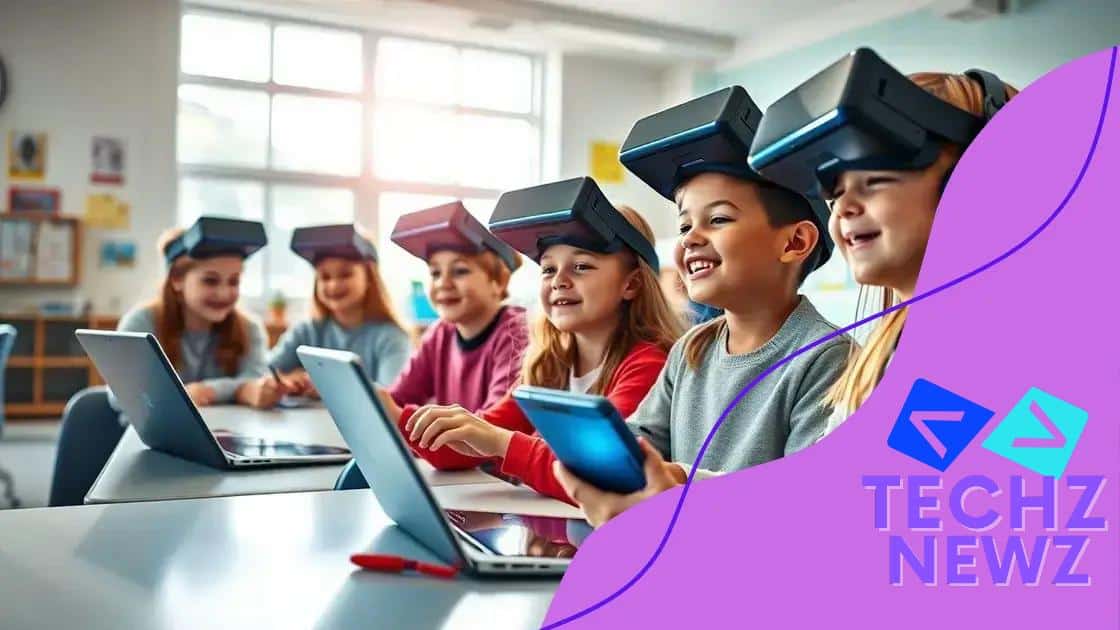AI tools for monitoring student participation and progress

AI tools for monitoring student participation and progress provide personalized learning experiences, real-time analytics, and improved collaboration, ensuring tailored educational support and enhanced engagement in classrooms.
AI tools for monitoring student participation and progress are becoming essential in today’s educational landscape. Have you ever wondered how technology can reshape the way we track student engagement? Let’s dive into it!
Understanding AI tools for education
Understanding AI tools for education is crucial for teachers and administrators who want to enhance learning environments. These tools harness the power of artificial intelligence, offering real-time insights into student engagement and performance.
What Are AI Tools?
AI tools can analyze vast amounts of data to identify patterns in student behavior. By utilizing algorithms, these tools can provide educators with valuable feedback on how students interact with the material. This feedback allows for timely interventions and tailored support for learners.
Benefits of AI Tools in Monitoring
Employing AI tools brings multiple advantages to educational settings:
- Enhanced Engagement: These tools can boost student interest by personalizing learning experiences.
- Data-Driven Insights: Educators receive actionable data that highlights areas needing improvement.
- Efficient Tracking: Monitoring participation and progress becomes faster and more accurate.
- Scalability: AI solutions can easily be implemented across various subjects and grade levels.
One significant aspect of these tools is their ability to adapt to different teaching styles and learning paces. For instance, some AI programs can suggest additional resources for students struggling with certain topics. This supports a more inclusive education, catering to diverse learning needs.
Moreover, AI tools help educators focus on teaching rather than administrative tasks. By automating routine data collection and analysis, teachers can dedicate more time to face-to-face interactions with students.
Examples of AI Tools in Action
Several AI tools are already making waves in the educational sector:
- Learning Analytics Platforms: These platforms track student progress and suggest improvements based on performance metrics.
- Chatbots: They provide instant answers to student queries, available 24/7.
- Adaptive Learning Software: This software modifies content delivery based on individual student performance.
By exploring these examples, educators can visualize how AI tools for education integrate into their classrooms and effectively enhance the learning experience. Incorporating such tools fosters a more dynamic and responsive educational landscape, ultimately benefiting both students and teachers.
Key features to monitor student progress
Key features to monitor student progress are essential for educators looking to enhance their teaching methods. These features enable effective tracking of how students engage with learning materials and their overall academic performance.
Real-Time Analytics
One significant capability is the use of real-time analytics. This feature allows teachers to access up-to-date information on student engagement. Quick assessments can highlight areas where students are excelling or struggling.
Customizable Dashboards
Customizable dashboards are also vital. They provide educators with a visual representation of data relevant to their teaching needs. Teachers can adjust metrics shown, helping them to focus on specific subjects or student groups.
Additionally, features such as notifications and alerts keep educators informed of potential issues. When a student’s performance sinks below a set threshold, a quick notification can prompt timely interventions. This proactive approach fosters a supportive learning environment.
Detailed Reporting
Another important aspect is detailed reporting capabilities. These reports showcase trends over time, helping educators identify long-term patterns in student performance. By examining this data, educators can adapt their teaching strategies to better meet student needs.
- Engagement Metrics: Track how often students interact with materials.
- Assignment Completion Rates: Measure how many students finish their assignments on time.
- Behavioral Observations: Record notes on student participation and behavior during classes.
Using these features together, educators can create personalized learning experiences. For instance, if a student consistently struggles with a topic, targeted resources can be assigned, ensuring they receive the help needed to succeed.
Moreover, the integration of feedback tools allows students to express their thoughts. Regular check-ins can help teachers gauge student sentiment and adjust strategies accordingly. Incorporating a mix of monitoring tools leads to an enriched educational experience, making tracking student progress more effective and insightful.
How AI enhances engagement in classrooms

AI enhances engagement in classrooms by introducing innovative tools that motivate students. These technologies create dynamic learning experiences that keep students actively involved in their education.
Personalized Learning Experiences
One of the most significant ways AI boosts engagement is through personalized learning experiences. With AI, educators can tailor lessons to meet individual student needs. This means that students can learn at their own pace, focusing on areas where they need more time.
Interactive Learning Tools
Interactive learning tools powered by AI also play a crucial role. Applications that use gamification make learning fun and engaging. Students earn rewards or badges for completing tasks, which encourages them to participate more actively in lessons.
Furthermore, AI can analyze student interactions during these activities. By assessing engagement levels in real-time, teachers can adjust strategies on the fly, ensuring every student remains involved.
Immediate Feedback
Another benefit is the provision of immediate feedback. AI systems can instantaneously assess a student’s answer and provide suggestions on how to improve. This instant response helps students learn from their mistakes quickly and keeps them motivated.
- Adaptive Learning: AI tools adjust the difficulty of tasks based on student performance.
- Collaborative Learning: Platforms that facilitate group work help students engage with peers.
- Virtual Reality Experiences: Immersive simulations allow students to explore concepts in depth.
The combination of these features ensures that lessons are not only informative but also captivating. Teachers who implement AI tools often notice a marked increase in classroom engagement as students become more invested in their learning journey.
As classrooms evolve to include AI technologies, the potential for enhanced student engagement continues to grow. By harnessing the power of artificial intelligence, educators can create environments where students thrive and actively participate in their education.
Challenges in using AI for monitoring
While AI offers great potential for monitoring student progress, several challenges can arise when implementing these technologies. Understanding these challenges is vital for educators and institutions to effectively integrate AI tools.
Data Privacy Concerns
One of the primary issues is data privacy. Schools collect vast amounts of sensitive student information, and using AI tools can pose risks if this data is not managed properly. Parents and students may be reluctant to share information if they feel it could be misused.
Resource Limitations
Resource limitations also present challenges. Many schools may lack the necessary funding, infrastructure, or training to implement AI solutions. This can hinder effective use, especially in lower-income districts where technology resources are stretched thin.
Moreover, the pace of technological change can overwhelm educators. Keeping up with new advancements in AI can be daunting. Training staff to use these tools effectively is crucial, as poorly implemented AI solutions can lead to inaccurate assessments of student progress.
Cultural Resistance
Cultural resistance to change can impede the adoption of AI in classrooms. Some educators may be skeptical about relying on technology for monitoring, preferring traditional assessment methods. This mindset can limit the effectiveness of AI tools and reduce their potential benefits.
- Implementation Challenges: Integrating AI tools into existing systems can be complex and time-consuming.
- Technical Issues: Software malfunctions or system failures can disrupt monitoring and learning processes.
- Bias in Algorithms: If not properly designed, AI tools can perpetuate existing biases, leading to unfair evaluations.
Understanding these hurdles is essential for responsible implementation. By addressing these challenges head-on, educators can harness the full potential of AI to monitor student progress while ensuring a safe and effective learning environment.
Future trends in AI education tools
Future trends in AI education tools are shaping the way we think about teaching and learning. With advancements in technology, we are entering an era where education can become more personalized and efficient.
Increased Personalization
One of the most promising trends is increased personalization. AI tools will analyze each student’s learning style and needs. This means lessons can be tailored specifically for them, allowing for a more engaging and effective learning experience.
Integration of Virtual Reality
Another exciting development is the integration of virtual reality (VR) in education. VR can immerse students in different environments for a deeper understanding of complex topics. Imagine studying history by walking through ancient cities or exploring the human body from the inside.
The use of AI data analytics will enhance VR experiences, providing educators with insights into student engagement and activity within these virtual spaces. Adaptive challenges within these experiences will keep students motivated and invested.
Enhanced Collaboration Tools
Future AI tools will also promote enhanced collaboration among students. AI can facilitate group projects by forming teams based on complementary skills and interests. Through digital platforms, students will interact more effectively, sharing ideas and perspectives in real time.
- Smart Tutoring Systems: AI-driven tutors that adapt to student needs will become commonplace.
- Automated Administrative Tasks: AI will streamline grading and scheduling, freeing up educators to focus on teaching.
- Data-Driven Insights: Tools will track learning progress and suggest areas for improvement.
AI education tools will also focus on inclusivity. Technologies will support diverse learning needs, ensuring that every student has access to quality education. As these trends continue to develop, the role of educators will shift to that of facilitators, guiding students through their personalized learning journeys.
By embracing these innovations, schools can create environments where every learner has the opportunity to thrive and excel in their education, paving the way for a brighter future.
AI tools are changing the way we monitor student progress. As we look to the future, these tools will continue to evolve, offering even more personalized and engaging experiences in classrooms. By addressing challenges and embracing trends, educators can create environments that empower every student to succeed. The use of AI will foster collaboration, enhance learning experiences, and promote inclusivity. As we move forward, it’s essential to remain open to the possibilities that AI offers, ensuring that education is accessible and effective for all learners.
FAQ – Frequently Asked Questions about AI Tools for Monitoring Student Progress
How do AI tools personalize learning experiences for students?
AI tools analyze student performance and learning styles to tailor educational content and pace, ensuring each student gets the support they need.
What types of data do AI tools collect to monitor student progress?
AI tools collect data on student engagement, assignment completion, test scores, and participation levels to provide comprehensive insights into their learning.
What challenges might schools face when implementing AI tools?
Schools may encounter data privacy concerns, resource limitations, and resistance to change from staff or parents when integrating AI technologies.
How can AI enhance collaboration among students in classrooms?
AI can form groups based on complementary skills and interests, promoting teamwork and encouraging students to engage with one another effectively.





